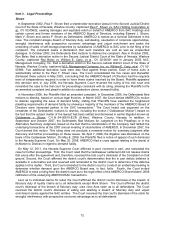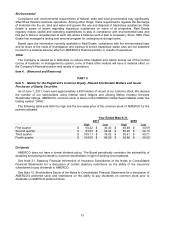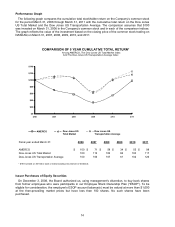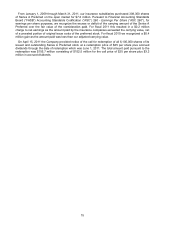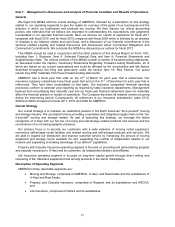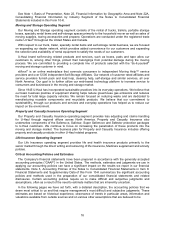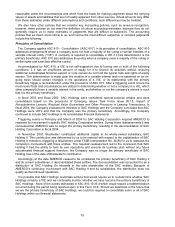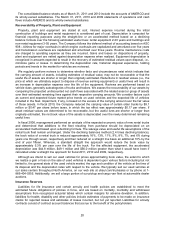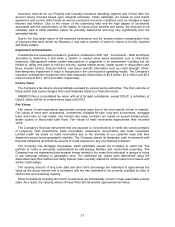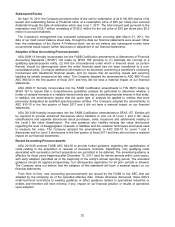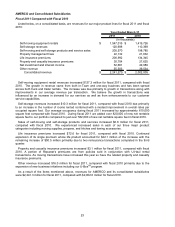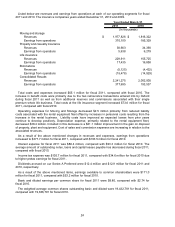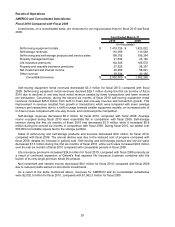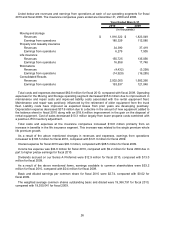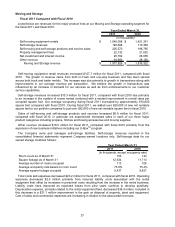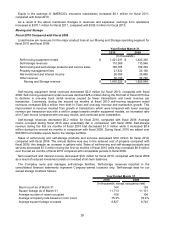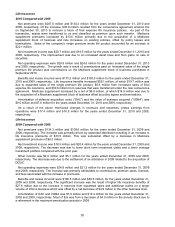U-Haul 2011 Annual Report Download - page 25
Download and view the complete annual report
Please find page 25 of the 2011 U-Haul annual report below. You can navigate through the pages in the report by either clicking on the pages listed below, or by using the keyword search tool below to find specific information within the annual report. 20
The consolidated balance sheets as of March 31, 2011 and 2010 include the accounts of AMERCO and
its wholly-owned subsidiaries. The March 31, 2011, 2010 and 2009 statements of operations and cash
flows include AMERCO and its wholly-owned subsidiaries.
Recoverability of Property, Plant and Equipment
Property, plant and equipment are stated at cost. Interest expense incurred during the initial
construction of buildings and rental equipment is considered part of cost. Depreciation is computed for
financial reporting purposes using the straight-line or an accelerated method based on a declining
balance formula over the following estimated useful lives: rental equipment 2-20 years and buildings and
non-rental equipment 3-55 years. The Company follows the deferral method of accounting based on ASC
908 - Airlines for major overhauls in which engine overhauls are capitalized and amortized over five years
and transmission overhauls are capitalized and amortized over three years. Routine maintenance costs
are charged to operating expense as they are incurred. Gains and losses on dispositions of property,
plant and equipment are netted against depreciation expense when realized. Equipment depreciation is
recognized in amounts expected to result in the recovery of estimated residual values upon disposal, i.e.,
minimize gains or losses. In determining the depreciation rate, historical disposal experience, holding
periods and trends in the market for vehicles are reviewed.
We regularly perform reviews to determine whether facts and circumstances exist which indicate that
the carrying amount of assets, including estimates of residual value, may not be recoverable or that the
useful life of assets are shorter or longer than originally estimated. Reductions in residual values (i.e., the
price at which we ultimately expect to dispose of revenue earning equipment) or useful lives will result in
an increase in depreciation expense over the life of the equipment. Reviews are performed based on
vehicle class, generally subcategories of trucks and trailers. We assess the recoverability of our assets by
comparing the projected undiscounted net cash flows associated with the related asset or group of assets
over their estimated remaining lives against their respective carrying amounts. We consider factors such
as current and expected future market price trends on used vehicles and the expected life of vehicles
included in the fleet. Impairment, if any, is based on the excess of the carrying amount over the fair value
of those assets. In fiscal 2010, the Company reduced the carrying value of certain older trucks by $9.1
million or $0.47 per share before taxes, in which the tax effect was approximately $0.17 per share. If
asset residual values are determined to be recoverable, but the useful lives are shorter or longer than
originally estimated, the net book value of the assets is depreciated over the newly determined remaining
useful lives.
In fiscal 2006, management performed an analysis of the expected economic value of new rental trucks
and determined that additions to the fleet resulting from purchase should be depreciated on an
accelerated method based upon a declining formula. The salvage value and useful life assumptions of the
rental truck fleet remain unchanged. Under the declining balances method (2.4 times declining balance),
the book value of a rental truck is reduced approximately 16%, 13%, 11%, 9%, 8%, 7%, and 6% during
years one through seven, respectively and then reduced on a straight line basis an additional 10% by the
end of year fifteen. Whereas, a standard straight line approach would reduce the book value by
approximately 5.3% per year over the life of the truck. For the affected equipment, the accelerated
depreciation was $44.8 million, $49.1 million and $56.0 million greater than what it would have been if
calculated under a straight line approach for fiscal 2011, 2010 and 2009, respectively.
Although we intend to sell our used vehicles for prices approximating book value, the extent to which
we realize a gain or loss on the sale of used vehicles is dependent upon various factors including but not
limited to, the general state of the used vehicle market, the age and condition of the vehicle at the time of
its disposal and the depreciation rates with respect to the vehicle. We typically sell our used vehicles at
our sales centers throughout North America, on our web site at uhaul.com/trucksales or by phone at 1-
866-404-0355. Additionally, we sell a large portion of our pickup and cargo van fleet at automobile dealer
auctions.
Insurance Reserves
Liabilities for life insurance and certain annuity and health policies are established to meet the
estimated future obligations of policies in force, and are based on mortality, morbidity and withdrawal
assumptions from recognized actuarial tables which contain margins for adverse deviation. In addition,
liabilities for health, disability and other policies include estimates of payments to be made on insurance
claims for reported losses and estimates of losses incurred, but not yet reported. Liabilities for annuity
contracts consist of contract account balances that accrue to the benefit of the policyholders.




